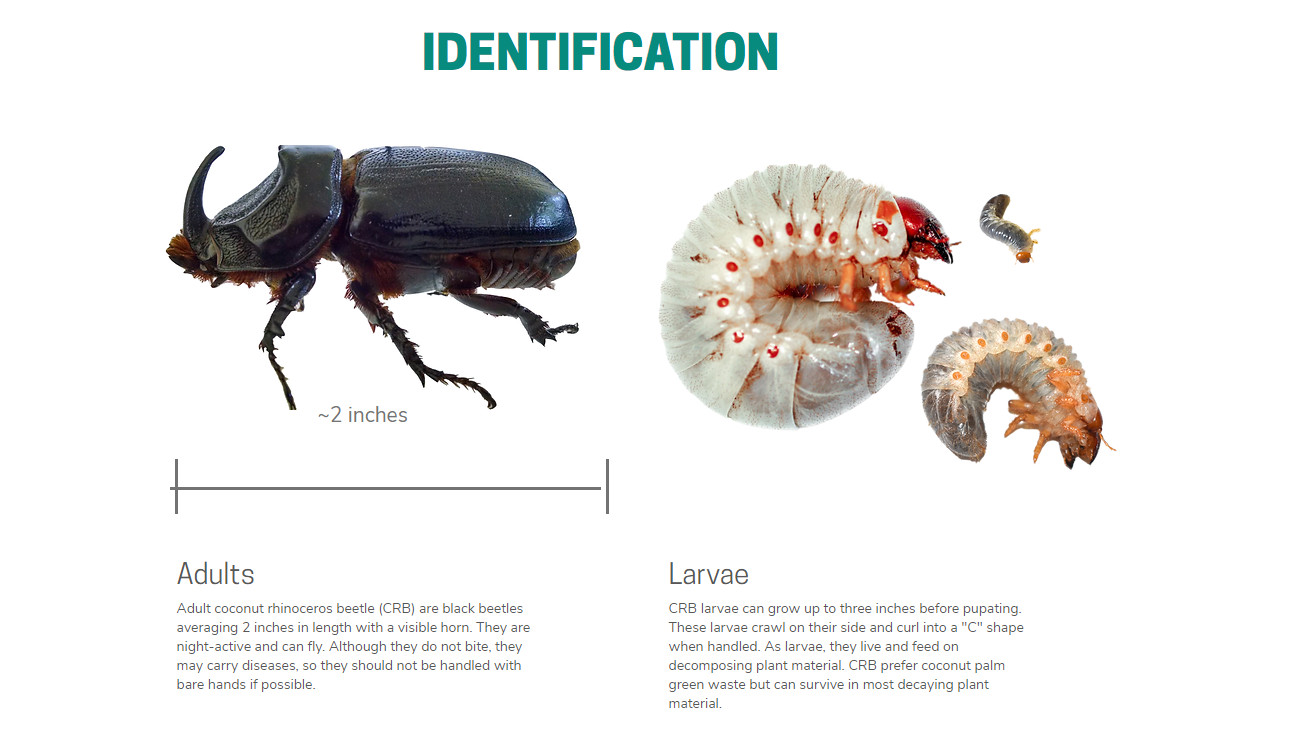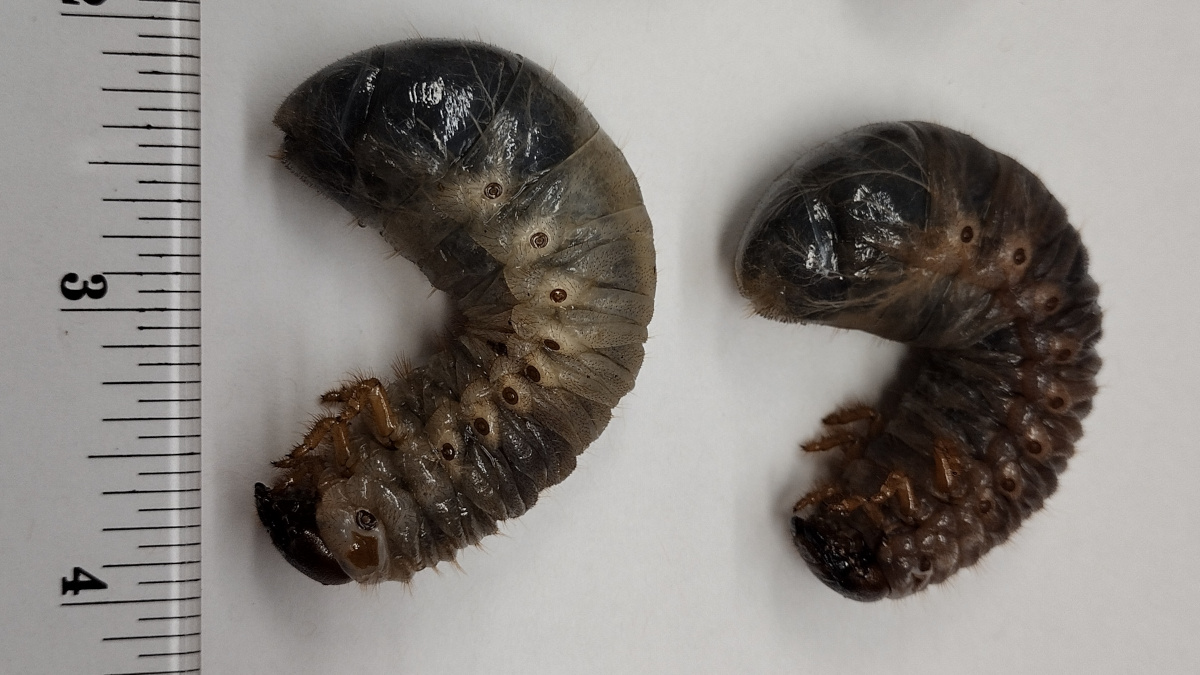(BIVN) – There have been no additional coconut rhinoceros beetles detections on Hawai‘i Island, state officials say, since the discovery of several live CRB grubs in Waikoloa in October 2023.
The Hawaiʻi Department of Agriculture provided the update Wednesday, in a news release detailing recent efforts to hunt down CRB infestations on Maui.
From the Hawaiʻi DOA:
In a multi-agency effort, treatments, inspections and surveillance continue on Maui for coconut rhinoceros beetles (CRB). To date, no CRB have been confirmed on Maui since an initial detection of 17 live CRB larvae in one palm tree in Kīhei in November 2023. One dead CRB adult was found at a Maui retail store in September 2023.
During the week of March 25, a second round of pesticide treatments was conducted over a three-day period when 78 palm trees were treated for CRB at a Kīhei golf course and compost facility. The treatment was led by the Maui Plant Pest Control Branch (PPC) of the Hawai‘i Department of Agriculture (HDOA) with the assistance from the Maui Invasive Species Committee (MISC) and its drone and the staff from the University of Hawai‘i-Hilo’s Spatial Data and Visualization Lab, who piloted the drones.
The treatment area was monitored from March 25 to April 8 and no CRB were found. Monitoring will continue weekly for the next few months. Drones have been found to be the most effective and efficient method in treating the crowns of palm trees which can measure up to 90 feet.
The first round of drone treatments in Kīhei was conducted in mid-February 2024, when 24 palm trees were treated. Drone treatments were also conducted on Kaua‘i in October 2023.HDOA and MISC have surveyed a total of 26,000 palms throughout Maui County and about 80 detection traps have been deployed and are being monitored. So far, no CRB have been detected in those traps.
“It is encouraging that no CRB have been detected on Maui in four months,” said Sharon Hurd, chairperson of the Hawai‘i Board of Agriculture. “However, the department and its partner organizations will continue be vigilant and work to prevent CRB from becoming established in uninfested areas. We encourage the public to be on the lookout for CRB and to check their green waste and compost piles which are notorious breeding grounds.”
HDOA’s Pesticides Branch applied for and received a crisis emergency exemption from the U.S. Environmental Protection Agency (EPA) to treat palms with the pesticide, cypermetherin, which has been found to be effective in killing CRB. The EPA has only authorized its use in the counties of Maui, Kaua‘i and Hawai‘i Island.
In addition to pesticide treatments, HDOA’s Maui Plant Quarantine Branch (PQ) conducts inspections five times a week at the port where interisland barge shipments arrive and conduct outreach and education with port employees. Maui PQ and PPC staff also conduct inspections at Maui big-box retailers at least twice a week or more and inspect bagged propagation material arriving from O‘ahu for possible CRB entry and exit holes. Shipments of mulch, compost and bagged plant propagation material are treated before leaving O‘ahu. Maui staff continue to inspect bulk containers of compost arriving from O‘ahu and are monitoring nurseries, landscaping operations, compost and waste sites and golf courses on a regular basis. On Moloka‘i, inspection and education efforts continue at stores that sell propagative plant material.
Aside from their regular inspection duties, HDOA inspection staff conduct outreach and education activities at landscape companies, vendors of planting materials, and farming and community groups.
On Hawai‘i Island, six live CRB grubs were found in Waikoloa Village in October 2023. A Hawai‘i Island PPC specialist travels weekly from Hilo to Kona to survey for possible CRB infestations with the volunteer assistance of area residents. More than 70 detection traps have been deployed on the east and west sides of the island. To date, no additional CRB have been detected on Hawai‘i Island.
On Kaua‘i, CRB was first detected near Līhu‘e Airport in May 2023. Since then, more than 95 traps have been deployed around Kaua‘i. At last report, a total of about 74 beetles have been found in traps on the island. Multi-agency eradication efforts continue on the island.
Suspected CRB on Maui, Hawai‘i Island and Kaua‘i should be reported to the State’s Pest Hotline 808-643-PEST (7378). More information on CRB may be found at: crbhawaii.org.
Background
CRB were first detected in Hawai‘i in December 2013 on O‘ahu, where they have gradually spread to areas around the island.
CRB are a serious pest of palm trees, primarily coconut palms, as the adult beetles bore into the crowns of the palms to feed on the tree’s sap. New unopened fronds are damaged in this way and when fully opened, may break and fall unexpectedly. If CRB kill or damage the growing point of the palm, the tree may die. Secondary fungal or bacterial pathogens may also attack the wounds caused by CRB, thereby killing the tree as well. Tree mortality after CRB attack has been reported to be anywhere from 10 percent to 50 percent. Dead trees then become a safety hazard as they may fall unexpectedly after the trunk rots, potentially resulting in bodily injury or property damage.
It is a major pest of palms in India, the Philippines, Palau, Fiji, Wallis, Nukunono, American and Western Samoa and Guam. It is still not known exactly how the beetles arrived in Hawai‘i.



by Big Island Video News7:23 am
on at
STORY SUMMARY
HONOLULU - State officials gave an update on the multi-agency effort to treat, inspect and survey the island of Maui for coconut rhinoceros beetles.